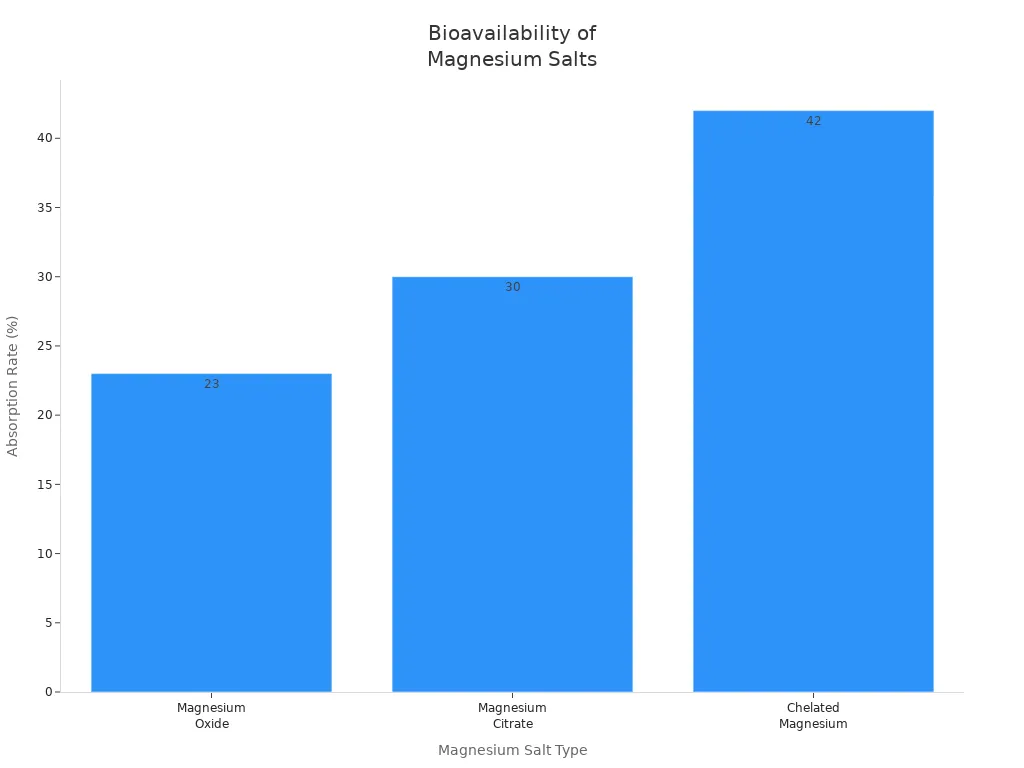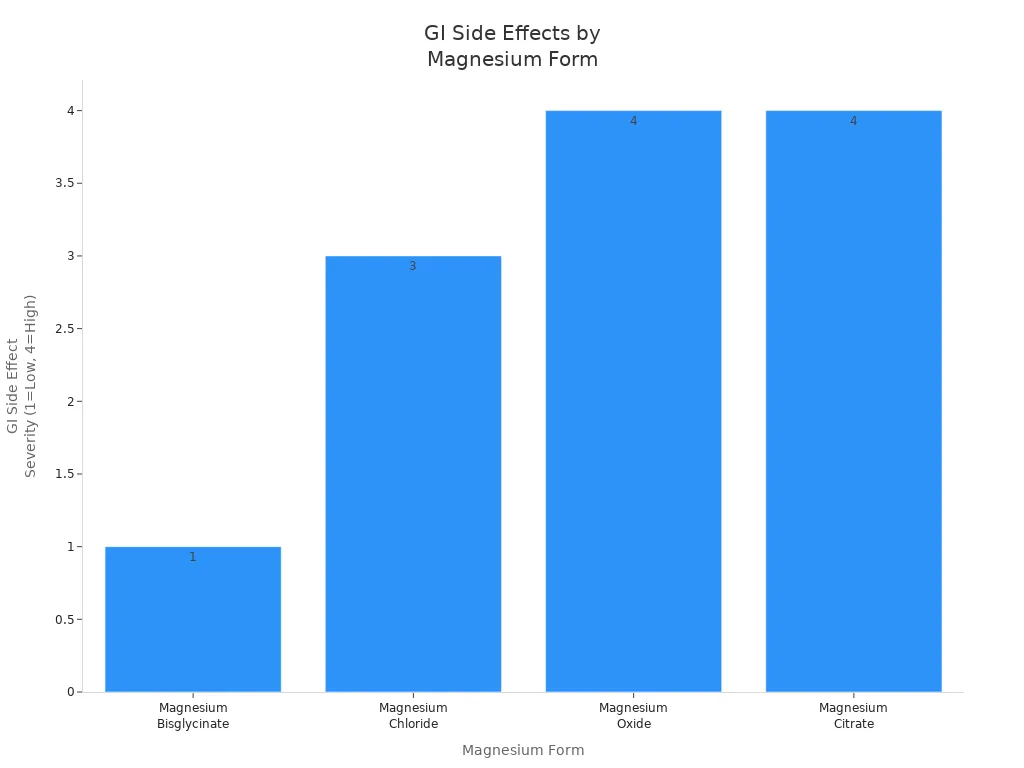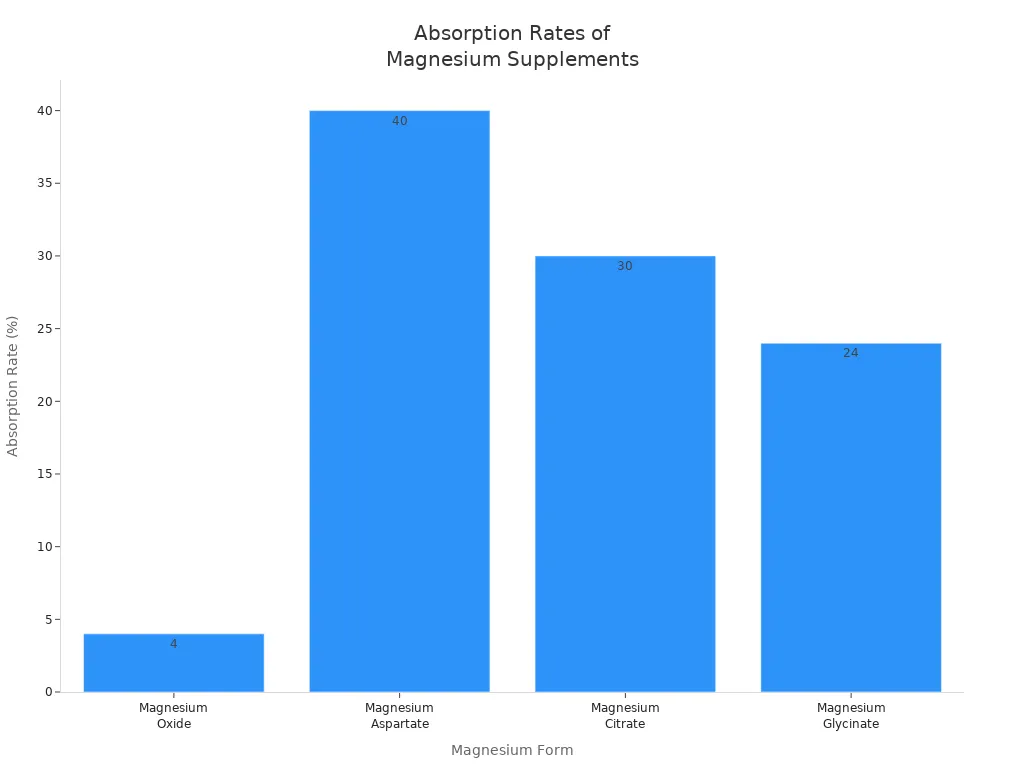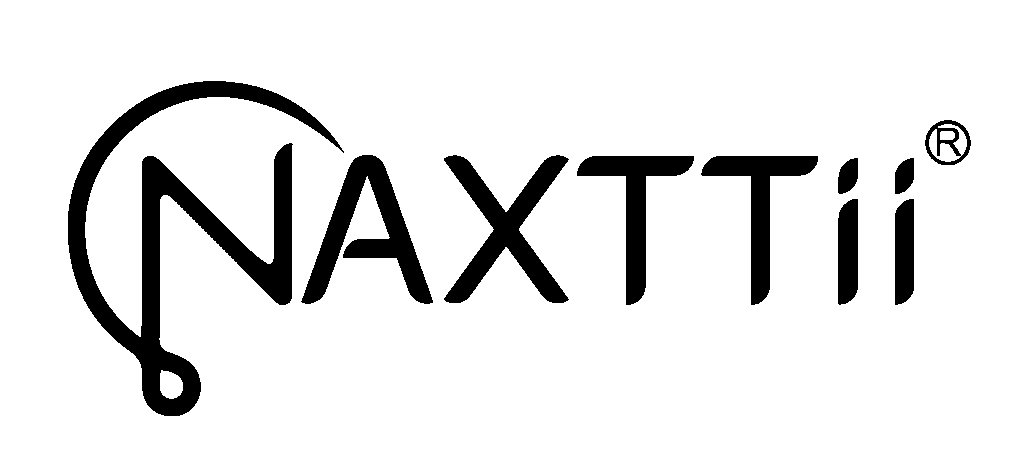Understanding Chelated Magnesium and Its Health Impact
Table of Contents

Chelated magnesium is a form of this essential mineral where magnesium binds to amino acids. This process helps your body absorb and use magnesium more efficiently. Not all magnesium supplements work the same way. You need to pay attention to absorption and bioavailability because these factors affect how much of the supplement your body can use. Studies show that between 10% and 30% of adults worldwide experience magnesium deficiency, with some groups facing even higher rates.
| Population Group / Study Context | Prevalence of Magnesium Deficiency (%) |
|---|---|
| General population (various studies) | 10% – 30% |
| University students in Brazil | 42% |
| Mexican adults (men/women) | 31% / 36.3% |

You can choose chelated magnesium for better absorption and fewer digestive side effects compared to other forms. This makes magnesium supplementation more effective for supporting your health.
Chelated Magnesium Basics

What Is Chelated Magnesium
You may wonder what sets chelated magnesium apart from other forms of magnesium. Chelated magnesium is a special compound where magnesium binds to a larger molecule, usually an amino acid. This process, called chelation, comes from the Greek word for “claw” because the amino acid wraps around the magnesium like a claw. This bond creates a stable complex that your body can absorb more easily. Unlike non-chelated forms such as magnesium oxide or magnesium sulfate, chelated magnesium does not exist as a simple salt. Instead, it forms a mineral complex with a chelating agent, which helps your body use it more efficiently.
Many supplements use chelated magnesium to improve stability and reduce digestive discomfort. You will often see magnesium chelate forms like magnesium glycinate, magnesium malate, or magnesium taurate on supplement labels. These forms use amino acids or organic acids to create a chelate, making them easier on your stomach and more effective for nutrient absorption.
Tip: If you see “glycinate,” “malate,” or “taurate” on a magnesium supplement, you are likely looking at a chelated magnesium product.
How Chelation Works
Chelation changes how your body absorbs and uses magnesium. When magnesium binds to an amino acid, it forms a ring structure called a chelate. This structure protects the magnesium as it moves through your digestive system. The chelating agent, such as glycine or taurine, acts like a shield. It keeps the magnesium stable and prevents it from reacting with other nutrients or stomach acids.
| Chelation Aspect | Explanation |
|---|---|
| Chelation Definition | Magnesium binds with an organic ligand, forming a ring structure with higher bioavailability. |
| Ligand Role | Small ligands like glycine create stable, neutral chelates that your body absorbs intact. |
| Absorption Mechanism | Chelated magnesium avoids competition at mineral receptors and is absorbed more efficiently. |
| Benefits | Protects magnesium from stomach acid, reduces side effects, and improves mineral uptake. |
Your body absorbs chelated magnesium through protein pathways in the intestine. This means the magnesium chelate can pass through the gut wall without breaking apart. As a result, you get more magnesium into your bloodstream, which leads to high bioavailability and better utilization by your cells. Non-chelated forms, on the other hand, often break down in the stomach and compete with other minerals for absorption. This can lower their effectiveness and cause more digestive side effects.
You will find that the most common chelating agents in supplements include:
- Glycine (magnesium glycinate or bisglycinate)
- Taurine (magnesium taurate)
- Malic acid (magnesium malate)
- Lysine (magnesium lysinate)
- Orotic acid (magnesium orotate)
These amino acid chelates offer superior bioavailability and are gentler on your digestive system compared to inorganic forms like magnesium oxide.
Why Chelation Matters
Chelation plays a key role in making magnesium supplements more effective. When you take a magnesium chelate, your body absorbs a much higher percentage of the mineral. For example, magnesium glycinate can have absorption rates as high as 80-90%. In contrast, non-chelated forms like magnesium oxide may only reach 4-7%, and magnesium citrate about 25-30%. This difference means you get more benefit from each dose of chelated magnesium.
High bioavailability is important because it ensures your body can use the magnesium you take. Better absorption leads to improved support for muscle, nerve, and heart health. It also helps with energy production and immune function. Chelated magnesium avoids common problems like digestive upset and poor nutrient absorption. This makes it a smart choice if you want to maximize the effectiveness of your supplement.
Note: Poor magnesium absorption can lead to muscle cramps, fatigue, and even heart rhythm problems. Choosing a magnesium chelate with high bioavailability helps prevent these issues and supports your overall well-being.
You may notice that chelated magnesium supplements cost more than non-chelated forms. This is because the manufacturing process is more complex. However, the benefits of superior bioavailability and better utilization often make the investment worthwhile.
Absorption
Bioavailability of Magnesium
You need to understand how your body absorbs magnesium to get the most benefit from your supplement. Bioavailability means how much of a nutrient your body can actually use after you take it. Magnesium absorption happens mostly in your small intestine. When you choose a magnesium chelate, you help your body absorb more of the mineral. This leads to high bioavailability and better utilization.
Magnesium chelate forms, such as magnesium glycinate or aspartate, protect the mineral as it moves through your digestive system. The chelation process keeps magnesium from binding to things that block absorption. This results in enhanced absorption and superior bioavailability. Clinical studies show that chelated magnesium can reach absorption rates up to 70% in some cases. This means your body gets more magnesium where it is needed, helping you maintain optimal magnesium levels.
When you have high bioavailability, you support your muscles, nerves, and heart more effectively. You also improve nutrient absorption and overall health.
Chelated Magnesium vs. Non-Chelated
Not all magnesium supplements work the same way. The form you choose affects how much magnesium your body can use. Here is a table comparing the absorption rates of common magnesium forms:
| Magnesium Salt | Elemental Magnesium Content (%) | Approximate Absorption Rate (%) |
|---|---|---|
| Magnesium Oxide | 60 | 23 |
| Magnesium Citrate | 11 | 30 |
| Chelated Magnesium (e.g., Aspartate, Lactate) | 8-12 | ~42 |

You can see that magnesium oxide has the highest elemental content, but your body absorbs much less of it. Magnesium citrate does a little better, but chelated magnesium forms offer the highest absorption rates. This means you get more benefit from each dose, even if the elemental magnesium content is lower.
People with digestive disorders often struggle with magnesium absorption. Conditions like Crohn’s disease or celiac disease can lower how much magnesium your body takes in. Magnesium chelate forms, such as magnesium diglycinate, help overcome these problems. They provide superior bioavailability and fewer digestive side effects, such as diarrhea or stomach cramps.
Common side effects of non-chelated magnesium supplements include:
- Diarrhea
- Stomach cramps
- Nausea
Chelated magnesium forms are gentler on your stomach. They cause fewer side effects, even at higher doses. This makes them a better choice if you want high bioavailability and improved utilization.
Choosing a magnesium chelate helps you achieve optimal magnesium levels with less risk of digestive upset.
Health Benefits

Muscle and Nerve Support
You rely on magnesium for strong muscle and nerve function. This mineral helps your muscles contract and relax. It also supports nerve transmission, which allows your body to send signals quickly and accurately. Although many people believe magnesium supplements can reduce muscle cramps, scientific studies show mixed results. Most research finds no significant difference between magnesium and placebo for reducing muscle cramps in older adults, pregnant women, or patients with kidney disease. Researchers note that small sample sizes and short study periods limit these findings.
- Observational studies link low magnesium levels to muscle cramps.
- Randomized trials do not show clear benefits for cramp reduction.
- Adverse events are similar between magnesium and placebo groups.
Magnesium plays a key role in nerve health. Neurological research shows that magnesium, especially chelated forms, helps protect neurons from damage. It regulates synaptic plasticity, which is important for learning and memory. Magnesium blocks NMDA receptor calcium channels, preventing cell swelling and death after nerve injury. It also reduces inflammation and promotes nerve regeneration.
| Mechanism/Effect | Description |
|---|---|
| NMDA receptor antagonism | Blocks calcium influx, protects neurons from injury |
| Inhibition of excitotoxicity | Prevents glutamate-induced nerve damage |
| Anti-inflammatory action | Reduces cytokines, supports nerve repair |
| Promotion of nerve regeneration | Improves neurobehavioral and electrophysiological functions |
| Anti-apoptotic effects | Increases protective proteins, decreases cell death factors |
Magnesium supports muscle health and nerve function, helping you maintain energy levels and overall wellness.
Sleep and Stress Relief
You may notice improved sleep when you increase your magnesium intake. A recent clinical trial found that adults taking chelated magnesium for two weeks experienced better sleep quality, longer sleep duration, and more deep sleep. No adverse events were reported, and participants followed the regimen closely. Other studies show that magnesium L-aspartate and magnesium citrate can help people fall asleep faster and improve sleep quality, especially in older adults.
Magnesium glycinate and magnesium L-threonate are chelated forms that may help you achieve improved sleep. These forms activate GABA receptors and boost melatonin production, which promote relaxation and improved sleep quality. Magnesium oxide does not show the same consistent effects.
If you struggle with sleep, chelated magnesium may help you relax and enjoy deeper rest.
Magnesium also plays a role in mood regulation and stress relief. Some studies suggest magnesium may reduce mild anxiety and premenstrual anxiety symptoms, but results are not consistent. Clinical experience shows that chelated magnesium forms like bis-glycinate and threonate are popular for their calming effects. Magnesium acts as a natural relaxant by enhancing GABA activity and regulating stress hormone release. However, more research is needed to confirm these health benefits for stress and anxiety.
Heart and Bone Health
Magnesium supports heart health in several ways. Long-term studies show that people with higher magnesium intake have fewer heart disease complications, lower rates of arrhythmias, and reduced mortality. Magnesium supplementation improves endothelial function, exercise tolerance, and reduces the risk of coronary heart disease. In patients with heart failure, magnesium helps lower blood pressure, reduce vascular resistance, and decrease arrhythmias.
Magnesium acts as a natural calcium channel blocker, promoting vasodilation and blood pressure regulation. Chelated magnesium, such as magnesium taurate, is better absorbed and causes fewer digestive side effects. Combining magnesium with potassium and a low sodium diet enhances its antihypertensive effects.
Magnesium also plays a critical role in bone health. About 60% of your body’s magnesium is stored in your bones. Low magnesium content leads to brittle bones and increases the risk of osteoporosis. Magnesium deficiency can cause low calcium levels and impaired vitamin D function, which contribute to bone loss.
- Magnesium supplementation reduces parathyroid hormone levels and increases bone formation markers.
- Studies show increased bone density and fewer fractures in postmenopausal women who take magnesium.
- Magnesium combined with calcium leads to greater bone mineral density increases.
Magnesium helps regulate bone turnover, supports calcium absorption, and maintains bone strength. You can promote heart health and protect your bones by maintaining healthy magnesium levels.
Metabolism and Immunity
Magnesium is essential for energy levels and metabolic health. It acts as a cofactor in enzymatic reactions that control glucose metabolism and insulin function. Chelated magnesium, such as magnesium glycinate, is well absorbed and suitable for people with diabetes. Magnesium supports insulin sensitivity by enhancing insulin binding and promoting glucose uptake.
- Magnesium activates enzymes for glucose metabolism.
- Magnesium deficiency worsens insulin resistance and blood sugar control.
- Magnesium provides anti-inflammatory and cardiovascular benefits for metabolic health.
Magnesium also supports immune system function. It helps activate cytotoxic T cells, which target infected and cancerous cells. Magnesium binds to proteins on T cells, keeping them active and effective. Low magnesium levels can impair immune function and reduce the effectiveness of cancer immunotherapy. While no direct evidence shows that chelated magnesium specifically enhances immune system support, maintaining healthy magnesium levels is important for your body’s defense.
Digestive Comfort
You may worry about digestive side effects when taking magnesium supplements. Chelated magnesium forms, such as magnesium bisglycinate, are absorbed more efficiently and cause fewer gastrointestinal issues. Clinical trials show that magnesium bisglycinate does not increase diarrhea or nausea compared to placebo. Magnesium oxide and citrate, on the other hand, often cause diarrhea and stomach cramps.
| Magnesium Form | Absorption Compared to Mg Oxide | Gastrointestinal Side Effects | Mechanism / Notes |
|---|---|---|---|
| Magnesium Bisglycinate (Chelated) | 8.8x greater absorption than Mg oxide | Fewer GI side effects; no significant increase in diarrhea or nausea in clinical trials | Uses active absorption via amino acid chelation, enhancing bioavailability and gut tolerance |
| Magnesium Oxide | Baseline (lowest absorption) | Commonly causes diarrhea, abdominal cramping | Poorly absorbed rock-salt form; relies on passive diffusion; osmotic laxative effect |
| Magnesium Citrate | Higher absorption than oxide | Laxative effect; can cause diarrhea and GI discomfort | Osmotic effect increases bowel fluid; good absorption but less gut-friendly than chelated forms |

Chelated magnesium is preferred for digestive comfort. You can support energy levels, muscle health, and overall wellness without worrying about unwanted side effects.
Choosing chelated magnesium helps you enjoy the health benefits of improved sleep, muscle and nerve function, heart health, and immune system support with better digestive comfort.
Chelated Magnesium vs. Others
Common Magnesium Forms
You will find many types of magnesium chelate in supplements. Each form has different uses and absorption rates. Here is a table that shows the most common forms and how well your body absorbs them:
| Magnesium Form | Approximate Absorption Rate | Common Uses / Notes |
|---|---|---|
| Magnesium Oxide | ~4% (lowest absorption) | Heartburn, indigestion, constipation |
| Magnesium Aspartate | ~40% (highest absorption) | Deficiency, energy support |
| Magnesium Citrate | ~30% | Constipation, bone health |
| Magnesium Glycinate | ~24% | Anxiety, sleep, gentle on stomach |
| Magnesium Chloride | High bioavailability | Type 2 diabetes, general supplementation |
| Magnesium Malate | High bioavailability | Chronic pain, fibromyalgia |

You can see that magnesium oxide is common but has the lowest absorption. Magnesium aspartate, citrate, and malate offer much better absorption. Magnesium glycinate is also popular for its gentle effect on your stomach.
Unique Advantages
Magnesium chelate stands out because your body absorbs it more easily. You get more benefit from each dose. Magnesium chelate forms, like glycinate and malate, are less likely to cause stomach upset or diarrhea. Healthcare professionals often recommend these forms for people who need an effective supplement with fewer side effects.
A clinical trial compared several forms of magnesium chelate. The study found that chelated forms, such as bisglycinate, kept blood magnesium levels higher for longer. Participants also had fewer digestive problems. You can trust magnesium chelate to deliver steady results and better comfort.
Tip: If you want a supplement that works well and is easy on your stomach, choose a magnesium chelate.
Magnesium Chelate in Supplements
Magnesium chelate, especially magnesium glycinate, is a top choice in the supplement market. Many brands use it because it offers high absorption and gentle effects. The market for magnesium glycinate continues to grow as more people learn about its benefits for muscle, nerve, and bone health. You will see magnesium glycinate in products from leading brands, often labeled as a premium option.
Magnesium chelate is favored by athletes, health-conscious people, and those with magnesium deficiency. You can rely on it for consistent results and fewer side effects. Magnesium chelate stands out as an effective supplement for daily use.
Usage and Safety
Dosage Guidelines
You need to know how much magnesium chelate to take for your age and health status. The recommended daily intake changes as you grow. Children need less magnesium than adults. Pregnant women require more magnesium to support their health. You should not exceed the maximum supplemental dose for your age group. Always check with your healthcare provider before starting magnesium supplementation, especially if you have health conditions.
| Age Group / Condition | Recommended Magnesium Intake (mg/day) | Maximum Supplemental Dose (mg/day) |
|---|---|---|
| Children 1-3 years | 80 | 65 |
| Children 4-8 years | 130 | 110 |
| Children 9-13 years | 240 | 350 |
| Females 14-18 years | 360 | 350 |
| Females 19-30 years | 310 | 350 |
| Females 31+ years | 320 | 350 |
| Pregnant (varies by age) | 350-400 | 350 |
| Breastfeeding (varies by age) | 310-360 | 350 |
| Males 14-18 years | 410 | 350 |
| Males 19+ years | 400-420 | 350 |

You can use magnesium chelate for sleep, muscle cramps, or blood sugar support. Most adults take between 300 and 420 mg per day. You should follow the label instructions and never take more than the recommended dose.
Side Effects and Safety
Magnesium chelate is safe for most people when used correctly. You may experience mild side effects such as diarrhea, nausea, or stomach pain. Serious side effects are rare but can include allergic reactions, muscle weakness, or slow heartbeat. People with kidney disease should avoid magnesium supplementation unless a doctor approves it. You need to watch for drug interactions with antibiotics or osteoporosis medications.
| Safety Aspect | Details |
|---|---|
| Contraindications | Allergy to magnesium chelate; kidney disease |
| Monitoring | Blood tests; kidney function checks |
| Serious Side Effects | Severe diarrhea; muscle cramps; allergic reactions |
| Common Side Effects | Diarrhea; nausea; stomach pain |
| Overdose Symptoms | Numbness; limp muscles; slow heartbeat; vomiting |
| Drug Interactions | Antibiotics; osteoporosis drugs; antacids |
| Precautions | Consult doctor if diabetic, have digestive disorders, or heavy alcohol use |
| Pregnancy and Nursing | Consult doctor before use |
| Usage Instructions | Take with water; do not exceed recommended dose |
Tip: You should always talk to your doctor before starting magnesium supplementation, especially if you have health problems or take other medicines.
Choosing Quality Supplements
You want to choose a magnesium chelate supplement that is safe and effective. Look for products from trusted brands that use third-party lab testing. Check for certifications from groups like USP or NSF International. Select magnesium chelate forms such as glycinate or citrate for better absorption and fewer side effects. Make sure the label matches the actual magnesium content. Avoid supplements with heavy metals or unnecessary additives.
- Pick supplements with high bioavailability, like magnesium glycinate.
- Check for third-party testing and quality certifications.
- Review the label for dosage and magnesium form.
- Avoid products with fillers or artificial ingredients.
- Choose the delivery method that fits your needs, such as capsules or powders.
You can support your energy levels and overall health by choosing a high-quality magnesium chelate supplement.
You now understand how chelated magnesium offers better absorption and fewer side effects than other forms. Choosing the right supplement helps you support muscle, nerve, and heart health.
- Look for high-quality chelated magnesium.
- Read labels carefully.
- Talk to your healthcare provider before starting any supplement.
Taking small steps today can help you build a stronger, healthier future. 🌱
FAQ
What is the best time to take chelated magnesium?
You can take chelated magnesium at any time. Many people prefer taking it with meals to help absorption. If you use it for sleep, try taking it 1–2 hours before bedtime.
Can you take chelated magnesium with other supplements?
Yes, you can take chelated magnesium with most vitamins and minerals. Avoid taking it at the same time as high-dose calcium or zinc. These minerals may compete for absorption.
Who should avoid chelated magnesium supplements?
People with kidney disease should not use magnesium supplements unless a doctor approves. If you have allergies to any ingredients, check the label before use.
Does chelated magnesium cause diarrhea?
Chelated magnesium is less likely to cause diarrhea than other forms. You may still get mild stomach upset if you take too much. Start with a low dose to see how your body reacts.

Poseidon
Master of Nutritional Epidemiology, University of Copenhagen, Herbal Functional Nutrition Researcher
Focus: The scientific application of natural active ingredients such as Tongo Ali, Horny Goat Weed, and Maca to sexual health and metabolic regulation.
Core Focus:
Men: Use a combination of Tongo Ali (an energizing factor) + Maca (an energy reserve) to improve low energy and fluctuating libido.
Women: Use a combination of Horny Goat Weed (a gentle regulator) + Maca (a nutritional synergist) to alleviate low libido and hormonal imbalances.
Stressed/Middle-Aged Adults: This triple-ingredient synergy supports metabolism, physical strength, and intimacy.
Product Concept:
Based on traditional applications and modern research (e.g., Tongo Ali promotes testosterone-enhancing enzyme activity, and icariin provides gentle regulation), we preserve core active ingredients and eschew conceptual packaging—using natural ingredients to address specific needs.
Simply put: I'm a nutritionist who understands "herbal actives." I use scientifically proven ingredients like Tongo Ali, Epimedium, and Maca to help you make "sexual health" and "nutritional support" a daily routine.
